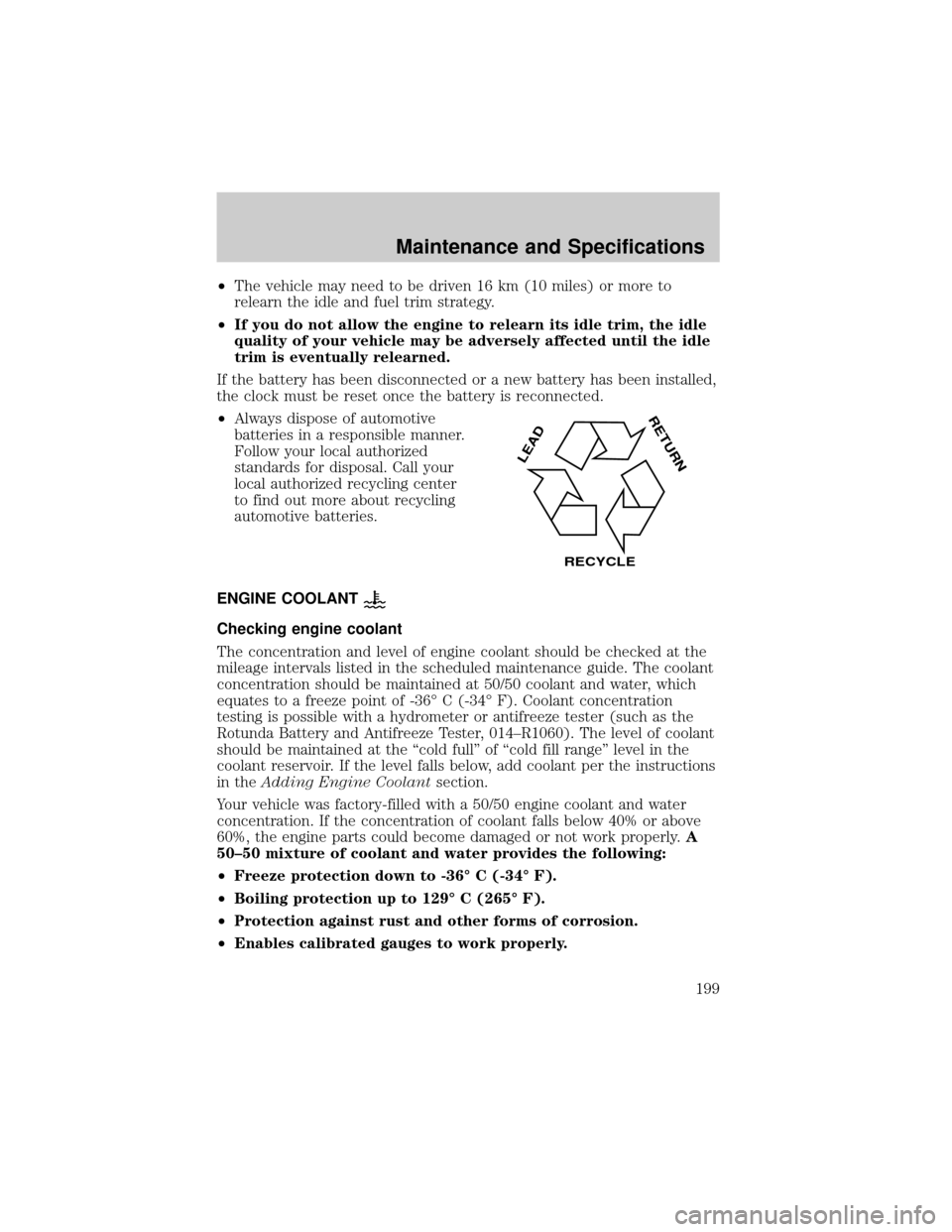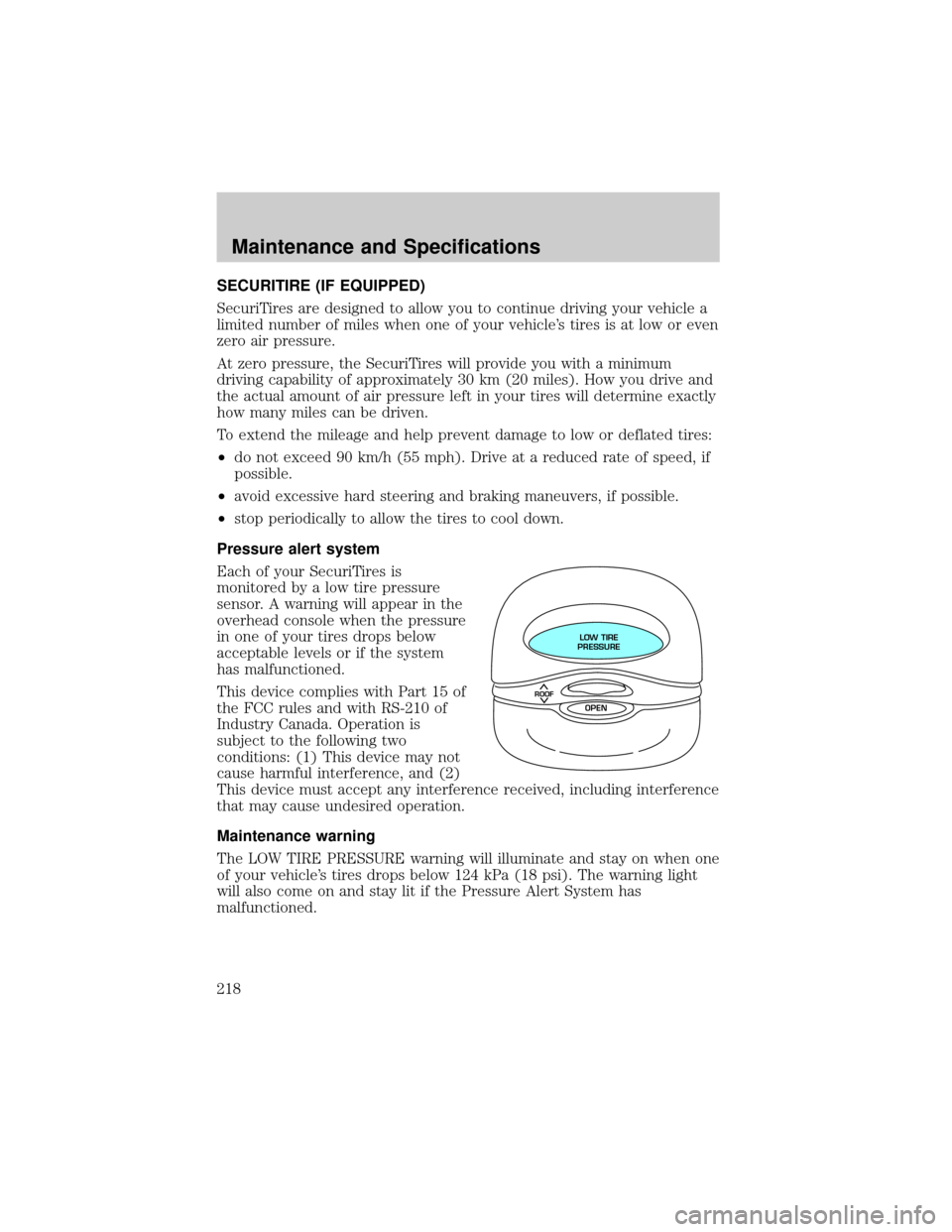mileage LINCOLN CONTINENTAL 2002 Owners Manual
[x] Cancel search | Manufacturer: LINCOLN, Model Year: 2002, Model line: CONTINENTAL, Model: LINCOLN CONTINENTAL 2002Pages: 240, PDF Size: 1.79 MB
Page 178 of 240

Board membership
The Board consists of:
²three consumer representatives
²a Ford or Lincoln Mercury dealership representative
Consumer candidates for Board membership are recruited and trained by
an independent consulting firm. The dealership Board member is chosen
from Ford and Lincoln Mercury dealership management, recognized for
their business leadership qualities.
What the Board needs
To have your case reviewed you must complete the application in the
DSB brochure and mail it to the address provided on the application
form. Some states will require you to use certified mail, with return
receipt requested.
Your application is reviewed and, if it is determined to be eligible, you
will receive an acknowledgment indicating:
²The file number assigned to your application.
²The toll-free phone number of the DSB's independent administrator.
Your dealership and a Ford Motor Company representative will then be
asked to submit statements.
To properly review your case, the Board needs the following information:
²Legible copies of all documents and maintenance or repair orders
relevant to the case.
²The year, make, model, and Vehicle Identification Number (VIN) listed
on your vehicle ownership license.
²The date of repair(s) and mileage at the time of occurrence(s).
²The current mileage.
²The name of the dealer(s) who sold or serviced the vehicle.
²A brief description of your unresolved concern.
²A brief summary of the action taken by the dealer(s) and Ford Motor
Company.
²The names (if known) of all the people you contacted at the
dealership(s).
²A description of the action you expect to resolve your concern.
Customer Assistance
178
Page 199 of 240

²The vehicle may need to be driven 16 km (10 miles) or more to
relearn the idle and fuel trim strategy.
²If you do not allow the engine to relearn its idle trim, the idle
quality of your vehicle may be adversely affected until the idle
trim is eventually relearned.
If the battery has been disconnected or a new battery has been installed,
the clock must be reset once the battery is reconnected.
²Always dispose of automotive
batteries in a responsible manner.
Follow your local authorized
standards for disposal. Call your
local authorized recycling center
to find out more about recycling
automotive batteries.
ENGINE COOLANT
Checking engine coolant
The concentration and level of engine coolant should be checked at the
mileage intervals listed in the scheduled maintenance guide. The coolant
concentration should be maintained at 50/50 coolant and water, which
equates to a freeze point of -36É C (-34É F). Coolant concentration
testing is possible with a hydrometer or antifreeze tester (such as the
Rotunda Battery and Antifreeze Tester, 014±R1060). The level of coolant
should be maintained at the ªcold fullº of ªcold fill rangeº level in the
coolant reservoir. If the level falls below, add coolant per the instructions
in theAdding Engine Coolantsection.
Your vehicle was factory-filled with a 50/50 engine coolant and water
concentration. If the concentration of coolant falls below 40% or above
60%, the engine parts could become damaged or not work properly.A
50±50 mixture of coolant and water provides the following:
²Freeze protection down to -36É C (-34É F).
²Boiling protection up to 129É C (265É F).
²Protection against rust and other forms of corrosion.
²Enables calibrated gauges to work properly.
LEAD
RETURN
RECYCLE
Maintenance and Specifications
199
Page 218 of 240

SECURITIRE (IF EQUIPPED)
SecuriTires are designed to allow you to continue driving your vehicle a
limited number of miles when one of your vehicle's tires is at low or even
zero air pressure.
At zero pressure, the SecuriTires will provide you with a minimum
driving capability of approximately 30 km (20 miles). How you drive and
the actual amount of air pressure left in your tires will determine exactly
how many miles can be driven.
To extend the mileage and help prevent damage to low or deflated tires:
²do not exceed 90 km/h (55 mph). Drive at a reduced rate of speed, if
possible.
²avoid excessive hard steering and braking maneuvers, if possible.
²stop periodically to allow the tires to cool down.
Pressure alert system
Each of your SecuriTires is
monitored by a low tire pressure
sensor. A warning will appear in the
overhead console when the pressure
in one of your tires drops below
acceptable levels or if the system
has malfunctioned.
This device complies with Part 15 of
the FCC rules and with RS-210 of
Industry Canada. Operation is
subject to the following two
conditions: (1) This device may not
cause harmful interference, and (2)
This device must accept any interference received, including interference
that may cause undesired operation.
Maintenance warning
The LOW TIRE PRESSURE warning will illuminate and stay on when one
of your vehicle's tires drops below 124 kPa (18 psi). The warning light
will also come on and stay lit if the Pressure Alert System has
malfunctioned.
ROOF
LOW TIRE
PRESSURE
OPEN
Maintenance and Specifications
218
Page 236 of 240

dipstick ....................................194
filter, specifications ........196, 224
recommendations ...................196
refill capacities ........................224
specifications ..................226±227
Exhaust fumes ..........................137
F
Floor mats ...................................57
Fluid capacities .........................224
Fuel ............................................204
calculating fuel economy .85, 209
cap ...........................................206
capacity ...................................224
choosing the right fuel ...........207
comparisons with EPA fuel
economy estimates .................212
detergent in fuel .....................208
filling your vehicle with
fuel ...........................204, 206, 209
filter, specifications ........209, 224
fuel filler door override ............89
fuel filler door release ..............89
fuel pump shut-off switch .....155
gauge .........................................15
improving fuel economy ........209
octane rating ...................207, 227
quality ......................................208
running out of fuel .................208
safety information relating to
automotive fuels .....................204
Fuses ..................................156±157
G
Garage door opener ....................68
Gas cap (see Fuel cap) ............206Gas mileage (see Fuel
economy) ...................................209
Gauges .........................................14
engine coolant temperature
gauge .........................................14
fuel gauge ..................................15
odometer ...................................15
speedometer .............................15
tachometer ................................15
GAWR (Gross Axle Weight
Rating) .......................................148
definition .................................148
driving with a heavy load ......148
location ....................................148
GVWR (Gross Vehicle Weight
Rating) .......................................148
calculating ...............................148
definition .................................148
driving with a heavy load ......148
location ....................................148
H
Hazard flashers .........................155
Head restraints .........................103
Headlamps ...................................40
aiming ..................................42±43
autolamp system .......................41
bulb specifications ....................46
daytime running lights .............40
flash to pass ..............................41
high beam ...........................13, 40
replacing bulbs .........................47
turning on and off ..............13, 40
warning chime ..........................13
Heating ........................................33
HomeLink universal
transceiver (see Garage door
opener) ............................68, 70±71
Index
236